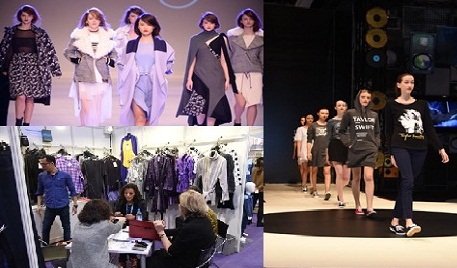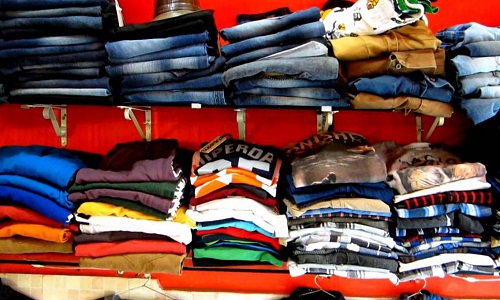FW
The HC has approved the amalgamation of Balkrishna Synthetics with Siyaram Silk Mills. Balkrishna Textiles was established in 1979 has over the years earned reputation as textile processors in the domestic and overseas markets. The company currently exports its product range made up of textiles and home textiles to the EU countries, US, CIS and exports fabrics to Indonesia, Malaysia, Middle East and Gulf countries. The company is into dyed and printed cotton fabrics and polyester fabrics, scarves, bottom weights, shirtings and corduroy fabrics, coated fabrics and value adds.
Siyaram, incorporated in 1978 and based in Mumbai, is a maker of blended fabrics and is a garment manufacturer, with an associated chain of retail outlets and branded showrooms. With a rich legacy of over 30 years, its bespoke men’s wear fashion is synonymous with high quality, continuous innovation and iconic futuristic designs which are local at heart and international in appeal.
Siyaram is India’s largest producer of blended high fashion suiting /shirting fabrics, manufacturing over 60 million meters of fabric annually. It has state-of-the-art manufacturing plants at Tarapur, Daman and Silvassa. An integrated distribution network, with over 0.1 million retail footprints across the country, makes high octane fashion accessible to the masses and the classes.
"The Hong Kong Trade Development Council (HKTDC) will launch this style show from Jan. 16-19at the Hong Kong Convention and Exhibition Centre. Marking its 48th anniversary, Hong KongFashion Week will feature approximately 1,500 international exhibitors focused on athleisure and trendy informal clothing."

For a seamless sourcing experience, the fair will be separated into 20 thematic zones for visiting buyers. The thematic zones will be divided by different categories, including the first-time appearances of Fashionable Sportswear and Casual Wear areas.
The Fashionable Sportswear zone would reflect the global affinity for fitness-oriented clothing. As wellness has become a worldwide trend, especially in the apparel market and athleisure has gained momentum in key fashion hubs such as Hong Kong. According to Euromonitor, the Chinese sportswear market has expanded by 11.3% year-on-year to $23,950,705,350 in 2015. HKTDC added the Fashionable Sportswear zone to incorporate the latest sports styles and provide business opportunities for buyers in the athleisure sector.

Casualwear has also become a popular trend in China, as the nation’s millennial dress more informally. Many Chinese and global brands are focusing on selling casualwear with trendy elements and fast turnaround times. The Casual Wear zone will be established for buyers that are interested in this relaxed apparel trend.
Other zones at Hong Kong Fashion Week include Thermal Clothing for cold-weather garments, clothing accessories for buyers interested in apparel embellishment, Men In Style, Fabric & Yarn, Knitwear and the International Fashion Designers’ Showcase.
Meet industry players and gather market intelligence at exciting events
The fair promises an exciting event line-up of fashion shows and parades, including the Brand Collections’ Show, Designers’ Collection Shows and the FASHIONALLY COLLECTION show which showcases the creative talents of the local new design forces. Experts from international trend forecasting agencies and industry professionals are invited to unveil the latest fashion trends and share updated market information at seminars and forums. Networking receptions will also be held to help participants expand their network of contacts and gather the latest market intelligence.
"Bangladesh's RMG exports to the global market rose by over 9 per cent to over $26 billion from Jan-Nov 2016. This growth rate is not sufficient to attain the $50 billion export target by 2021 as the sector needs over 12 per cent growth to realise the vision. Experts attributed remediation process, which helped improve safety standards-to the increased production capacity. Upon completion of remediation, some RMG units have received more orders from buyers who were satisfied with the safety progress, they argued."

Bangladesh's RMG exports to the global market rose by over 9 per cent to over $26 billion from Jan-Nov 2016. This growth rate is not sufficient to attain the $50 billion export target by 2021 as the sector needs over 12 per cent growth to realise the vision. Experts attributed remediation process, which helped improve safety standards-to the increased production capacity. Upon completion of remediation, some RMG units have received more orders from buyers who were satisfied with the safety progress, they argued.
As per World Trade Organisation (WTO), the global clothing export market has contracted by around 7.8 per cent to $445 billion in 2015. In 2014, the global apparel export was $483 billion while the global RMG export market is expected to reach $650 billion by 2021.
Production to get a boost

According to the data of Export Promotion Bureau (EPB), during January-November 2016, Bangladesh earned $26.09 billion, exporting clothing products, which is 9.03 per cent higher compared to $23.93 billion a year ago. Knitwear products fetched $12.56 billion with an 8.22 per cent rise compared to $11.60 billion in the previous year while woven products earned $13.53 billion, which is 9.78 per cent higher compared to $12.32 billion a year ago.
Exporters Association of Bangladesh President Abdus Salam Murshedy expects a double digit growth as the production capacity as well as the volume of work orders have increased because of safety improvement and remediation completion in most factories. Last year production was hampered due to the ongoing remediation to improve safety standard in workplaces for ensuring workers' safety. After the full-fledged completion of Corrective Action Plans (CAPs), the work order flow would increase and it would be possible to attain a double-digit growth, added the business leader.
According to Mahmud Hasan Khan Babu, VP, BGMEA, the sector has seen less investment as manufacturers had to spend a lot on remediation and safety improvement. Experts feel that in order to expand, RMG sector requires investment to increase production capacity for gaining more global market share. Gas connection is a big challenge for Bangladesh's RMG. The country has to work on technology up-gradation and high-end products. Bangladesh has to now focus on capacity building and set strategies to move to high-end and branded fashion segments. Currently, about 79 per cent of Bangladesh export items are concentrated in five basic products – trouser, t-shirt, sweater, shirts and jackets mostly made of cotton.
Another priority area is market diversification as Bangladesh's apparel exports are mostly concentrated on EU and North America. Non-traditional market is the key element to enlarge the export volume. The contribution of non-traditional markets to total export was 2 per cent in FY2005-06, which has increased to 15 per cent in FY'16.
The 2017 spring edition of Yarn Expo will be held from March 15 to 17 at the National Exhibition and Convention Center (Shanghai). Over years, the Expo has increased in stature in the global yarn and fibre market and is expected to feature more exhibitors in its next edition.
Its scale is expected to jump by 20 per cent and will occupy 18,000 sq. m. compared to 15,000 sq. m. in 2016 to accommodate the increase in exhibitors. Nearly 360 exhibitors will bring together some of the world’s highest quality yarn and fibre products such as natural and blended yarns including cotton, wool, flax / regenerated flax, silk, and man-made fibres and yarns as well as specialty products including elastic and fancy and blended yarns.
Last year’s Yarn Expo Spring edition attracted 20,527 buyers from 77 countries and regions creating an unrivalled platform for exhibitors to reach all kinds of buyers from around the world. To take advantage of this diverse buyer profile, a number of international suppliers have already confirmed their participation this year. After the rewarding results in last autumn fair, Birla Planet will return to present a series of Birla Spunshades, Birla Micro-Viscose and Birla Micro Modal products.
Furthermore, the Cotton Textile Export Promotion Council (TEXPROCIL) will once again organise the Indian Pavilion to feature India’s top cotton yarn and fibre suppliers. Besides the India Pavilion, Pakistan Zone will return as well and so will exhibitors from Uzbekistan and Vietnam who will also showcase competitive cotton yarns, elastic yarns and eco products to diversify the sourcing options for buyers. Meanwhile, a wide range of high quality synthetic, knitting and metallic yarns will be brought by exhibitors from Indonesia, Korea, Singapore, Slovakia and Thailand to cater to the rapidly growing demand for these products in the global market.
LIVA, a leading fashion fabric brand from Aditya Birla has launched its first and India’s only state of the art studio exclusively for their LIVA Accredited Partner Forum (LAPF) partners at Noida. LIVA Accredited Partner Forum (LAPF) is the first of its kind platform in the textile fraternity that connects and builds a network of textile professionals.
The LAPF studio harnesses the strength of one of the largest garment clusters in the world where over 650 garment units are located. It will act as a one-stop customer experience centre for technical, product and marketing solutions. The studio offers more than 1,000 fabrics of Viscose, Modal & Excel on display with detailed technical specifications along with wide variety of fabrics including woven, knitted, flat knitted etc. Also on display would be LIVA’s seasonal collection specially designed by its in-house designers.
The launch was attended by Rajeev Gopal, Chief Marketing Officer, Birla Cellulose and Birla Cellulose team from across India and Lalit Thukral, President Noida Apparel Export Cluster (NAEC). Well-known fashion designer Narendra Kumar and celebrity jewellery designer Riddhima Kapoor Sahni marked their presence and added fashion quotient to the event and inaugurated the Studio in Noida.
Talking about the features of LAPF studio, Rajeev Gopal, CMO, Grasim said the LAPF studio will act as an enabler for the company’s value chain partners for which they were happy to associate with the Noida garment cluster. This is a key source to clothing brands across the world.
LAPF studio connects with over 650 garment manufacturers & exporters over 50 local & international brands, 50 international buying houses, agents and traders, 100 fashion design houses. Brand Liva’s journey of collaboration with the entire value chain of textile industry is taking firm roots with such initiatives.
The West Bengal Garment Manufacturers and Dealers Association (WBGMDA) is hosting a three-day textile fair in Kolkata. The fair that started from today (January 5) will go on to January 7. Vijay Kariwala, VP of WBGMDA informed that the fair would have 102 participants who make for more than 300 brands in total. The fair will witness the presence of kids wear players mainly owing to the fact Kolkata is known as the hub for the garment industry. Over 500 wholesalers from different parts of the country have confirmed their presence in the fair.
“The event is a core B2B fair where the organizers are expecting big retailers, prominent wholesalers, distributors and agents on a pan-India basis. In the three days, the organizers are anticipating about 1,500 visitors from Delhi, Mumbai, Lucknow, Amravati, Indore, Patna, Assam etc.
This is one of the best platforms for buyers, retailers and wholesalers in the region. It is organised on a pan-India level to offer opportunities to stakeholders. The popularity of the fair has been increasing and a good deal of business is expected this time.
Sri Lanka recorded its highest-ever level of apparel exports during the year ending December 2017. The Joint Apparel Association Forum (JAAF) reports that Sri Lanka's total apparel export figure last year was over $4.8 billion, which was an increase of 3.06 per cent over 2016. However, Sri Lanka has not yet announced its official full-year (2017) total textile export figures. During 2017, Sri Lanka had exported apparel valued at over $2.2 billion to the US (up by 1.9 per cent as against 2016), $2.0 billion worth of apparel to EU nations (up by 4 per cent) and $630 million to the rest of the world (up by 3.7 per cent) .
JAAFs general secretary Tuly Cooray has said they had set an ambitious target of $5.2 billion in textile and apparel exports for 2018 and an $8 billion apparel export target in 2020. "We are happy to say that we are gradually gaining the benefits of GSP+; during the last two or three months, it has really boosted our exports," he said. The apparel sector in Sri Lanka's is both the highest industrial employment generator and its highest foreign exchange earner.
The Central Bank, in a statement, said Sri Lanka's export earnings from garments increased for the fifth consecutive month in November 2017, largely due to increased demand from the EU, the US and non-traditional markets such as Australia, Hong Kong and the UAE. Their records show Sri Lanka's earnings from textiles and garments during the first eleven months of 2017 increased by 1.6 per cent year-on-year to $4.6 billion.
The first eleven months of 2017 recorded $1.96 billion in exports to the US and $1.8 billion in exports to the EU. Post restoration of the GSP+ facility, earnings from garment exports to the EU continued to grow and in November 2017, it grew by 13.8 per cent year-on-year, while garment exports to the US increased by 11.9 per cent.
Switzerland-based systems manufacturer Oerlikon Barmag is a solutions provider of efficient production processes. The new systems that will be commissioned over this year are primarily focused on the Asian region; however, Oerlikon is experiencing huge demand for industrial yarn systems from producers in Europe due to the comparably high margins and specialized areas of application. Customers are asking for products that offer an interesting margin, such as specialties and industrial yarns.
The company’s current machine concepts for industrial fine-titer nylon yarns allow it to offer configurations that are specifically tailored to the product requirements of the end application of these yarns, such as tents, tarpaulins, parachutes, etc. The focus of the machine design is both on the product quality of the yarns in typical titer ranges of between 20 and 70 den and on production efficiency and, above all, on the optimization of the conversion costs.
The market for industrial yarns is continuing to diversify and develop very much in line with specific end applications. The rising demand for so-called high-performance tires is resulting in both increased demand for PET HMLS yarns and in greater output of PA66 yarns for use in cap ply. The vast majority of the additional output of polyester and polyamide yarns will be deployed in the automotive sector (airbags, safety belts, tire cord).
Conversion of recycled carbon fibre composites into second life products’ will be a key theme at the forthcoming Nonwovens for High Performance Applications conference (NHPA 2017) that takes place in Prague on March 7 and 8. In the last year, ELG Carbon Fibre began manufacturing a range of nonwoven mats on a new production line at its plant in Coseley, UK.
The line, has been custom built to produce a variety of nonwoven materials, including 100 per cent recycled carbon fibre mats and thermoplastic blends such as carbon fibre mixed with PP, PA, PPS fibres. The machine is unique in being able to use reclaimed carbon fibres that have been obtained through pyrolysis of scrap prepreg materials or cured laminates, providing important feedstock flexibility compared to existing equipment available in the marketplace which can only accept dry manufacturing waste.
The obstacles the company has overcome in creating its new Carbiso M and Carbiso TM materials will be highlighted and the major opportunites offered by recycled carbon products will be discussed. ELG believes its range of materials will strongly appeal to OEMs in the transportation sector seeking cost effective options for lightweighting with its another key theme the conference.
In a keynote address at the Prague conference, Michael Effing, President of Composites Germany would talk about the current and future opportunities for nonwovens and other technical textile reinforcements in the fast-moving environment that is Europe’s composites industry. In the second keynote, sales director for industrial nonwovens at Tenowo Detlev, Käppel will explain how his company has transformed itself from a traditional German textiles company into a 21st Century leader in engineered nonwovens – most notably in lightweight components for the automotive sector.
In charting the company’s progress, the parallel expansion of a product portfolio of highly-engineered nonwovens and technical textiles will be detailed and lessons learned along the way shared. Tenowo has constantly expanded and now has major manufacturing plants in the USA, India and China as well as in Germany.
After submitting a concept note on a trade facilitation agreement on services at the World Trade Organization (WTO), India is planning to firm up its strategy for the next course of action across key issues at the multilateral body. The idea is to prepare a road map for post-Nairobi ministerial world order and take stock of steps already taken by the country at the WTO.
Doha round of negotiations has remained stalled since 2008 primarily over the issue of huge trade-distorting subsidies being given to farmers by rich countries. The fundamental objective at Doha was to improve trading prospects for developing nations. While India and other developing nations are waiting for this, developed countries are seeking to mostly dilute the negotiations and widen the mandate with new issues including e-commerce and the global value chain.
India has also been seeking concrete work plans on a special safeguard mechanism for developing countries to protect their farmers from a spurt in imports and on a permanent solution to the issue of its official grain procurement and food security in the country as agreed on in the Bali ministerial. The foreign trade policy of April 2015 targeted to double export of goods and services to 900 billion dollars by 2020.












